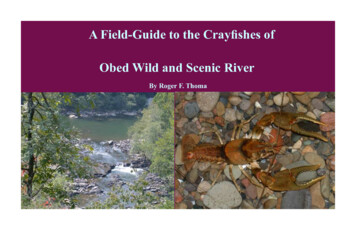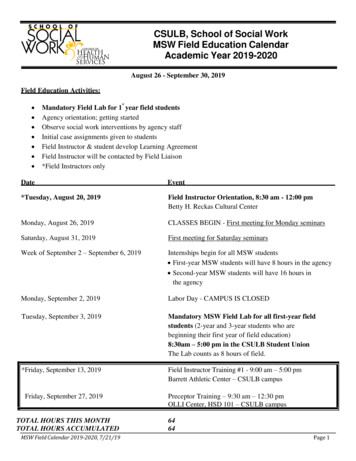
Transcription
A Field-Guide to the Crayfishes ofObed Wild and Scenic RiverBy Roger F. Thoma
ContentsIntroduction. 1How to identify a crayfish. 3Obed Emory River crayfish key. 6Species accounts. 10Thornytail crayfish. 10Upland burrowing crayfish. 12Mountain midget crayfish. 14Boxclaw crayfish. 16Hairyfoot crayfish. 18Obed River crayfish. 20Emory River crayfish. 22Tanback crayfish.24Valley flame crayfish.26Triangleclaw crayfish.28Ambiguous crayfish.30Bigclaw crayfish.32Rusty crayfish.34Literature.36
Introduction: The Obed National Wild and Scenic River National Park, located on the Cumberland Plateau ofTennessee, has thirteen species of crayfish living withinor near its boarders. These thirteen species come fromtwo genera in the family Cambaridae, a solely NorthAmerican crayfish family. There are currently sevenfamilies of crayfish worldwide.The two Obed genera are highly specious (approximately 100 species each) and widespread. They areCambarus and Orconectes. In total there are approximately 360 species of crayfish in the United States andCanada and approximately 80 species are known to occur in Tennessee.In the Obed area crayfish can be found in any surfacewater area and most areas where the water table is closeto the surface. Three of the species found in the Obedarea are burrowers that spend almost all of their lives inburrows and are rarely found out in open water. Crayfish display three basic life strategies; living in openwater and hiding under objects such as woody debrisand rocks, living in short burrows dug into stream banksor under large rocks, and burrowing vertically intoground water that is found near the surface. Technicalterminology for these life styles is tertiary, secondary,and primary burrowers respectively.The generalized pattern of reproduction in North American crayfish is normally to mate in late fall or earlyspring, laying of eggs from early spring to early summer and dispersal of young in mid summer. Crayfishmating is referred to as amplexus. Female crayfish carrya sperm plug with them in their annulus ventralis untilthey lay their eggs. The eggs are consequently carriedby the female on her pleopods as are the young untilthey are old enough to disperse.The life span of crayfish can vary based on the type ofhabitat a species occupies. Species that live in warmerwaters seem to live for about three to four years. Thosethat live in colder waters such as springs, burrows, andcaves can live from six to twenty plus years. Much workneeds to be done with crayfish life histories before
a solid understanding of the crayfish’s role in our ecosystems can be fully understood. It is generally understood that crayfish form an important factor in aquaticecosystems processing large portions of a systemsenergy and biomass as well as altering and creatinghabitat. Over 260 animal species are known to feed oncrayfish. Crayfish are known to feed at every level ofthe food chain.Special note: All line drawings used in this documentare derived from Hobbs, Jr. 1989, Taylor and Schuster2004 or self drawn.Maps: The maps provided in this field guide are focused on the Obed Emory River area. The map on thispage displays the drainage basin’s streams, collectionsites, and the three ecoregions in the area. Blue reprisents the Southwestern Appalachians, green the CentralAppalachians, and yellow the Central AppalachianRidge and Valleys Ecoregions. Streams are eithergreen, blue for the Emory River mainsten, or red forthe Obed River mainstem. Crayfish collection sites aredenoted with black dots. Each county is labeled.Figures: In each species account is a line drawingillustration derived from Hobbs, Jr. 1989. For thegenera Cambarus and Orconectes from left to right arefigured a dorsal view of the carapace, inner view firstform male gonopod, outer view first form male gonopod, outer view second form male gonopod, annulusventralis of female, and dorsal view of chelae 1.
How to identify crayfish: The figure above gives ageneralized outline of the body structure of a NorthAmerican crayfish. The most important body partsfor the identification of Obed crayfish on this figureare the rostrum (between the eyes), cervical spine (onthe side of the body), areola and its width (dorsal midbody), and the chelae’s propodus, dactyl and palm.The rostrum will either have or not have marginal(lateral) spines, the body will either have or not havecervical spines, and the width of the areola will bewide or narrow. Not figured is the tuberculation of thedorsal chelae palm. Palmer tubercles can be in rows orgenerally scattered about. There can be several rows oronly one row of tubercles and some rows can be complete (run the length of the palm) while others are incomplete. Also not illustrated are the tubercles on theinner margins of the chelae fingers. Of special use inthe Obed area is the presence of denticls on the innermargins of the chelae fingers. Denticles are very smallspine like structures that look like tiny teeth. A groupof three species have these small denticles running thefull length of the fingers with the denticles appearingbetween the larger tubercles. In the other species thedenticles do not run past the midpoint of the finger andare found near the tips or distal ends.Crayfish in North America go through reproductiveseasons or cycles. Associated with reproduction, malecrayfish display a special reproductive form referred to
as “first form”. When not in reproductive form a maleis called second form. Associated with each speciesaccount is a line drawing showing the shape of thefirst form and second form male gonopod. One mustlearn to distinguish between the two possible formsto be able to distinguish any two species in question.The first form male gonopod is always more delicatelysculptured and part of the tip will be a darker browncolor and is described as corneous (consisting of ahorny substance). The figures to the right show a firstform male (left) and a second form male (right) gonopod for the genera Orconectes (left) and Cambarus(right). The gonopod location is illustrated in the generalized crayfish drawing. They are labeled as Pleopods I. Female crayfish lack gonopods and betweenPereiopods V (fifth pair of legs) is found the annulusventralis. This structure is illustrated in the individualspecies accounts.When examining the chelae structure of a crayfish allcharacters are observed from the dorsal surface. Numerous tubercles can be observed on the mesial sur-face below the movable finger (the dactyl). This areais called the palm and the tubercles are called palmertubercles. Rows of tubercles are numbered from themesial margin inward as first row, second row, etc.Some species do not have their tubercles lined up inrows but scattered randomly across the surface, thoughon the inner edge of the palm tubercles can appear toform a row.The chelae have “fingers”. The fingers are formed bythe dactyl (the movable finger) and an extension ofthe propodus. On the opposable margins (the pinchingsurface) of the fingers are also found tubercles. Some
of these are larger than those surrounding. The location of these enlarged tubercles on the fingers can bediagnostic in the identification of a species. As discussed previously, some species have denticles (smallspine like teeth) that extend the length of the opposable finger margins while some have them half way orless down the fingers.The areola is an area of the body positioned betweenthe gill cambers and is located on the dorsal surfaceof the thorax. Life history habits are expressed in thestate of the areola. The width of the areola (spacebetween the suture lines) can aid in crayfish speciesidentification. Species in low oxygen waters will havenarrow areolas while those that inhabit high oxygenwaters will have wide areolas.The mandible, the last pair of appendages located atthe mouth, can be an aid in identification. The rustycrayfish, found at one site in the basin, has a uniquemandible that lacks the normal toothed margin and hasa blade like edge to it that identifies the species. Allother species in the basin have mandibles with teethextending the total length of the mandible edge.
Obed Emory River basin crayfish key1a) Rostrum with three spines at tip, 2 lateral (marginal) and one middle, carapace withcervical spines on sides (fig. 1a).21b) Rostrum without lateral spines, one spine at tip, no cervical spines (fig. 1b). 42a) Chelae with noticeable tuft of hairs at base of lateral finger (fig. 2a). .Tanback crayfish (pg. 24)2b) No tuft of hairs at base of chelae’s lateral finger.33a) Mandible with teeth on all of its edge.Bigclaw crayfish (pg. 32)3b) Mandible with blade like margin on distal edge.Rusty crayfish (pg. 34)
4a) Small tooth like denticles on inner margins of chelae fingers extending length of finger and found between tubercles near base of fingers.54b) Small tooth like denticles on inner margins of chelae fingers extending half way orless length of inner fingers.75a) Central projection of firstform male gonopod with subappical notch.65b) Central projection of firstform male gonopod without subappical notch. .Hairyfoot crayfish (pg. 18)6a) Central projection of firstform male gonopod approximately as long as messial process (fig. 5a) . .Obed River crayfish (pg. 20)6b) Central projection of firstform male gonopod approximately half as long as messialprocess (fig. 6a). Emory River crayfish (pg. 22)
7a) Areola closed, no space between edges of gill chambers (fig. 7a).87b) Areola open, space for one or more rows of punctations between edges of gill chambers (fig. 7b) . .98a) Palm of chelae with two distinct rows of tubercles, color in life red (fig. 8b). .Valley flame crayfish (pg. 26)8b) Palm of chelae with many tubercles covering inner, dorsal, half and not forming distinct rows, color in life mainly browns (fig. 8a).Thornytail crayfish (pg. 10)9a) Chelae of mature individuals triangular shaped, usually with two rows of easily seentubercles on inner margin, not forming a fussed ridge at base (fig. 9a).109b) Chelae of mature individuals more rectangular in shape, usually one row of tubercleson inner palm, tubercles forming a fussed ridge like structure at base (fig. 9b).11
10a) Suborbital angle acute, areola wide with three or more rows of punctationsin narrowest part (fig. 10a). Triangleclaw crayfish (pg. 28)10b) Suborbital angle obsolete, areola narrow with one or two rows of punctationsin narrowest part (fig. 10b).Ambiguous crayfish (pg. 30)11a) Eyes small, inner edge of antennal scale straight at mid point (fig. 11a). . Mountain midget crayfish (pg. 14)11b) Eyes not small, inner edge of antennal scale curved (fig. 11b).1212a) Coloration very bright in life having abundant reds and blues, areola narrow, usually with two rows of punctations, central projection of gonopod equal in length to mesialprocess (fig. 12a).Upland burrowing crayfish (pg. 12)12b) Coloration brown or greent in life, areola broad, usually with six or more rows ofpunctations, central projection of gonopod distinctly shorter than mesial process(fig. 12b). . Boxclaw crayfish (pg. 16)
Thornytail crayfishCambarus (Tubericambarus) acanthuraIdentification: Key characters are an obliterated areola that forms aline down the back, numerous tubercles on the chelae palm that do notform distinct rows, and two small median spines at the end of the tailthat project beyond the margins of the tail.The thornytail crayfish is unique in the Obed River area. No other species in the basin has two small spines overhanging the distal margin ofthe tail. Also, no other species has numerous tubercles that do not formdistinct rows covering the palm of the chelae. The upland burrowingand ambiguous crayfish can have very narrow areolas that can in someindividuals be obliterated but both have only one distinct row and occasionally a second less developed row of tubercles on the inner edgeof the chelae palm.Color: The color of the thornytail crayfish is dominated by browns, yellows,and greens. The color of the chelae isvaried. The tips of the “fingers” are redor reddish orange along with two tubercles at the base of the movable “finger”.The edges of the rostrum are red or yellowish orange. Tubercles on the chelaeare usually light cream. The head andbody are vermiculated with browns, yellows, and greens. Coloration can varywith age and time since molting.Photo by Zac Loughman.
Distribution: The thornytail crayfish is found in northwest Georgia, northeast Alabama, and southeast Tennessee in the Tennessee,Coosa, Black Warrior, and Chattahoochee River basins. The population discovered in the Emory River basin is the furthest northever recorded. It appears to be confined to the low gradient, lowrelief areas of the basin. Specimens have only been collected in theEmory River upstream of the Obed River and the Crooked Creekareas but it is likely it will be found all the way to the confluencewith the Tennessee River.Ecology/Life History: The thornytailcrayfish mates and lays eggs in the spring.The species burrows exclusively in wetland areas around streams, ditches, andwooded wetlands and is rarely foundoutside its burrow except in spring. Thebest populations seem to be from areasof ditched wetlands though this is likelyan artifact of the ease of collecting. Foodpreference is unknown but may be similarto the closely related little brown mudbugwhich waits at the mouth of its burrow andattacks small invertebrates that pass by.
Upland burrowing crayfishCambarus (Jugicambarus) dubiusIdentification: Key characters are a ridge like row of tubercles on inner edge of chelae palm, denticals extending less that half way down“fingers” of chelae, no lateral spines on rostrum, narrow areola, lengthof central projection of the firstform male gonopod usually equal to ornear equal to mesial process, life colors vibrant blues and reds.The upland burrowing crayfish is similar to the boxclaw crayfish andmountain midget crayfish. The upland burrowing crayfish has smalleyes. Boxclaw and mountain midget crayfish both have wide areolas.Other species in the basin either have lateral spines at the cervicalgroove and/or rostral margins, denticles that extend the length of thechelae “fingers”, or more than one well developed row of tubercles onthe chelae palm.Color: The color of the upland burrowing crayfish is dramatic. The specimenpictured here is a red body blue legcolor morph. Numerous color variations of this species can be found withinits range. Some populations are mostlyblue with some reds, or black with orange or red, some are all reddish orange,while some are solid blue, and many arevariations of the above color themes.Coloration within a population can varywith age and time since molting.Photo by Zac Loughman.
Distribution: The upland burrowing crayfish is a widely distributed species in the Appalachian Mountains. It is found from western Pennsylvania south through West Virginia, southwest Virginia,eastern Kentucky, eastern Tennessee, and northwestern NorthCarolina. The species shows no special association with drainagesas it is known to travel overland during wet spring nights. Withinthe Obed/Emory basin it is found throughout the area where suitable habitat can be found. Much of the basin is dominated by sandstone which limits suitable springs and seeps.Ecology/Life History: The upland burrowing crayfish mates in spring and fall.Egg production occurs in the spring andearly summer. This species burrows intosprings and seeps on hill sides and mountain tops. The best populations are fromareas of extensive forest cover thoughlike the picture above, at the type locality,healthy populations can be found in fields.Food preference appears to be vegetationand invertebrate animals. Numerous burrows have been observed with leaf litter,mosses and other plants stored in them.
Mountain midget crayfishCambarus (Jugicambarus) parvoculusIdentification: Key characters are ridge like row of tubercles on inner edge of chelae palm, denticals extending less that half way down“fingers” of chelae, no lateral spines on rostrum, wide areola, lengthof central projection of the firstform male gonopod equal to mesialprocess, antennal scale straight edged on inner margin.The mountain midget crayfish is similar to the boxclaw crayfishand upland burrowing crayfish. The boxclaw and upland burrowingcrayfish have larger eyes and rounded antennal scale margins. Otherspecies in the basin either have lateral spines at the cervical groove,denticles that extend the length of the chelae “fingers”, or more thanone well developed row of tubercles on the chelae palm.Color: The color of the mountainmidget crayfish is usually brown. Thespecimen pictured here is a blue colorphase individual. Normally, the body,chelae, and abdomen are a solid brown.The legs are always some shade ofblue. Tubercles on the chelae fingersare lighter colored than the backgroundand are usually a yellowish or creamcolor. Older, un-molted individuals canbe very dark to black due to staining byorganic matter.
Distribution: The mountain midget crayfish is a widely distributedspecies on the Cumberland Plateau and can be found in southeastern Kentucky in the Cumberland basin, eastern Tennessee in theTennessee and Cumberland River basins, and the northern cornersof Georgia and Alabama in the Sand Mountain area of the Tennessee basin. Within the Obed/Emory basin it is found throughout thearea.Ecology/Life History: The mountainmidget crayfish appears to mate fromspring to fall. Egg production occurs in thespring. This species lives in small sizedstreams and springs with rocky substrateswhere they burrow under aquatic mosscovered rocks and into rocky banks. Thebest populations are from streams with anextensive forest cover, especially thosedominated by hemlock and rhododendron.Food preferences as well as life span areunknown.
Boxclaw crayfishCambarus (Jugicambarus) distansIdentification: Key characters are a ridge like row of tubercles on inner edge of chelae palm, denticals extending less that half way down“fingers” of chelae, no lateral spines on rostrum, wide areola, lengthof central projection of the firstform male gonopod less than equal tomesial process.The boxclaw crayfish is similar to the mountain midget crayfish andupland burrowing crayfish. The mountain midget crayfish has smallereyes and the upland burrowing crayfish is usually very colorful withintense reds and blues. Other species in the basin either have lateralspines at the cervical groove, denticles that extend the length of thechelae “fingers”, or more than one well developed row of tubercles onthe chelae palm.Color: The color of the boxclaw crayfish is usually brown. The body andabdomen are a solid brown or browngreen. The chelae are brown but canhave an orange tint. The species canbe light in color. The legs are alwaysbrownish to cream colored and neverblue. Tubercles on the chelae fingers arelighter colored than the background andare usually a yellowish or cream color.Older, individuals can be very dark toblack due to staining by organic matter.Photo by Chris Lukhaup.
Distribution: The boxclaw crayfish is a widely distributed speciesand can be found in southeastern Kentucky in the Cumberland andKentucky River basins, eastern Tennessee in the Tennessee andCumberland River basins, and the northern corners of Georgia andAlabama in the Sand Mountain area of the Tennessee basin. Withinthe Obed/Emory basin it is found throughout the area.Ecology/Life History: Very little isknown about this specie’s life history.Reproduction may take place from springto fall. Egg production has never beenobserved. Boxclaw crayfish live in smallsized streams with rocky substrates wherethey burrow under rocks and into thebanks. The best populations are fromstreams with extensive forest cover. Foodpreferences as well as life span are unknown. They do not appear to requireas cold of water as the mountain midgetcrayfish.
Hairyfoot crayfishCambarus (Jugicambarus) crinipesIdentification: Key characters are denticals extending length of chelae“fingers”, no lateral spines on rostrum, one row of tubercles on thepalm, wide areola, length of central projection of the firstform malegonopod equal to mesial process and lacking a subappical notch.The Hairyfoot crayfish looks like the Obed River and Emory Rivercrayfishes. The only sure way to reliably tell this species from theother two is to examine the firstform male gonopod. Obed River crayfish have a subappical notch on the central projection and Emory Rivercrayfish have a central projection half the length to the mesial process.Other species in the basin have lateral spines on the rostrum or a rostrum that is not accuminate but sharply angled near the end, have twodistinct rows of tubercles on the inner edge of the chelae’s palm, or donot have denticals extending the length of the chelae “fingers”.Color: The color of the hairyfoot crayfish is rather drab. The body, legs, chelae, and abdomen are usually a mottledbrown, brownish green, or brownish orange. Shading can be very dark and thespecies is rarely light in color. Recentlymolted individuals may have orange orred finger tips. Tubercles on the chelae fingers are lighter colored than thebackground and are usually a yellowishor cream color. Older, un-molted individuals can be very dark to black due tostaining by organic matter.
Distribution: The hairyfoot crayfish is widely distributed in Tennessee and can be found in the Obey, Emory, and Big South ForkCumberland River basins in Cumberland, Fentress, Morgan, Overton, Putnam, and Scott Counties of Tennessee. Within the Obed/Emory basin it is confined to Clear Creek.Ecology/Life History: Very little isknown about this specie’s life history. It isknown that reproduction takes place in thefall and possibly spring. Egg production islow as the eggs are large and few in number. Hairyfoot crayfish live in small andmid sized streams with rocky substrateswhere they hide under rocks. In high gradient areas, where flows are strong, theyare found both at the stream edges andmidstream where they burrow under rocks.In low gradient streams they can be foundin the open stream and under rocks.
Obed River crayfishCambarus (Jugicambarus) species AIdentification: Key characters are denticals extending length of chelae“fingers”, no lateral spines on rostrum, one row of tubercles on thepalm, wide areola, a subappical notch on the central projection of thefirstform male gonopod, and a strongly defected mesial process.The Obed River crayfish looks like the Emory River crayfish andhairyfoot crayfish. The only sure way to tell this species from the othertwo is to examine the firstform male gonopod. Obed River crayfishhave a subappical notch on the central projection, hairyfoot crayfish donot, and Emory River crayfish have a central projection shorter thanthe mesial. Other species in the basin have lateral spines on the rostrum, two distinct rows of tubercles on the inner edge of the chelae’spalm, or denticles extending part way down the chelae “fingers”.Color: The color of the Obed Rivercrayfish is also rather drab. The body,legs, chelae, and abdomen are usuallya mottled brown, brownish green, orolive green. Shading can be very dark tomoderate dark. It is rarely light in color.Recently molted individuals will haveorange or red finger tips. Tubercles onthe chelae fingers are lighter coloredand are usually a yellowish color. Olderindividuals can be very dark to blackdue to staining by organic matter.Photo by Zac Loughman.
Emory River crayfishCambarus (Jugicambarus) species BIdentification: Key characters are denticals extending length of chelae“fingers”, no lateral spines on rostrum, one row of tubercles on thepalm, wide areola, central projection of the firstform male gonopodhalf the length of mesial process and with a subappical notch.The Emory River crayfish also looks like the hairyfoot crayfish andObed River crayfish. The only sure way to tell this species from theother two is to examine the firstform male gonopod. Obed River andhairyfoot crayfish have a central projection equal in length to themesial process. Other species in the basin either have lateral spineson the rostrum, two distinct rows of tubercles on the inner edge of thechelae’s palm, or denticles extending only part way down the chelae“fingers”.Color: The color of the Emory Rivercrayfish is rather drab. The body, legs,chelae, and abdomen are a mottledbrown, brownish green, or olive green.Shading can be dark to moderate dark.Shading is rarely light in color. Recentlymolted individuals may have orange orred finger tips. Tubercles on the chelaefingers are lighter colored than the background and are a yellowish or creamcolor. Older, individuals can be verydark to black from staining by organicmatter. Photo by Zac Loughman.
Tanback crayfishCambarus (Hiaticambarus) girardianusIdentification: Key characters are a distinct tuft of hairs at base ofimmovable “finger”, small spines on carapace sides at cervical grooveand lateral edges of rostrum, wide areola, and widely gaping chelae“fingers”.The Tanback crayfish is similar in general appearance to the bigclawand rusty crayfish, two species in the Obed/Emory basin that are froma different genus. All three species prefer larger streams and rivers andare adapted to that type of environment. The tanback crayfish is theonly species in the basin that has a distinct tuff of hairs at the base ofthe immovable “finger” of the chelae. In addition, male tanback crayfish have a gonopod with two elements recurved at a 900 angle insteadof pointing in line with the main shaft.Color: The color of the tanback crayfish is shades of brown and green. Twodark brown saddles run across the back,one at the cervical groove and one atthe posterior margin. The rostral margins are reddish brown and tubercles onthe chelae “fingers” are yellow. Somelarge individuals take on a metallic bluesheen on the chelae. Color patterns onthe abdomen create a scalloped appearance. A few blue phase individuals havebeen observed.
Distribution: The tanback crayfish is widely distributed in the Tennessee River and its tributaries from northeast Mississippi to Knoxville Tennessee. In the Obed area the best populations are found inthe larger river portions of the Emory River mainstem downstreamof the Obed River confluence. Populations have also been recordedfrom the Little Emory River, Daddys Creek, and upper Obed River.A good deal of variation is seen in the physical appearance andhabitat preferences of this species within its wide range.Ecology/Life History: In the Obed EmoryRiver system the tanback crayfish prefersthe larger water bodies of the mainstemwhere it lives under the larger flat rocks inthe vicinity of riffles and rapids. It is notfound directly in the rapids and riffles butat the head and foot of such areas whereit burrows under rocks. The food of thisspecies is unknown. Mating appears to occur in the spring and fall with egg production in spring. The specie’s life span maybe three to four years according to H. H.Hobbs Jr.
Valley flame crayfishCambarus (Depresicambarus) deweesaeIdentification: Key characters are an obliterated areola, suborbitalangle obsolete, two rows of tubercles on chelae palm, no lateral spineson rostrum or cervical groove, central projection of firstform malegonopod without subapical notch and shorter than mesial process.The valley flame crayfish is closely related to and physically similarto the triangleclaw and ambiguous crayfish. All three can have tworows of palmer tubercles. The triangleclaw crayfish has a wide, openareola and the ambiguous crayfish has a narrow areola that is usuallynarrowly open though some individuals have shown closed obliterated areolas. Valley flame crayfish can be distinguished from thornytailcrayfish by the absence of overhanging spines on the tail and only twowell organized rows of tubercles on the chelae palm.Color: The color of the valley flamecrayfish is rather straight forward. Allbody parts and appendages are someshade of red. Tubercles and the marginsof joints are usually a lighter red ororange. In Kentucky, some populationshave been recorded that have an overallblue body and appendages with red tubercles, joint margins, and rostrum andpostorbital ridges. This color morph hasnot been observed in the small Tennessee populations.
Dist
that live in colder waters such as springs, burrows, and caves can live from six to twenty plus years. Much work needs to be done with crayfish life histories before a solid understanding of the crayfish’s role in our ec











